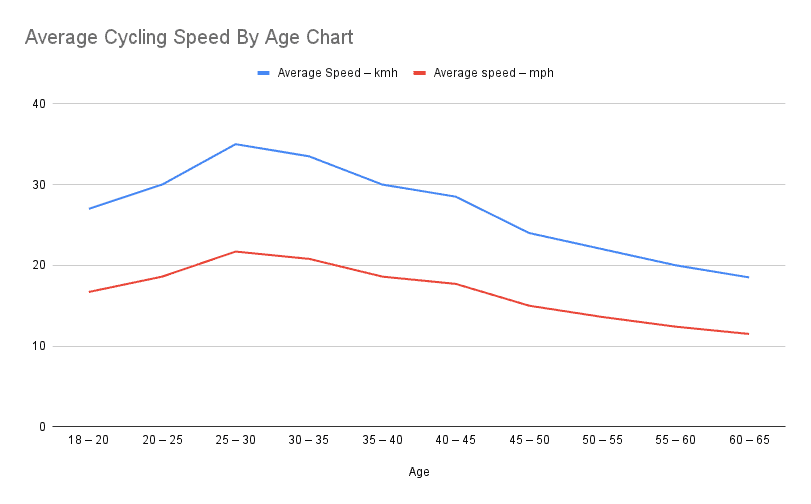Cycling and age are indirectly related to the power a biker produces. With growing age, there is a sudden decrease in power, hence, the decrease in average cycling speed.
That’s certainly not the type of answer that will quench your thirst and we know that.
Below mentioned is a complete discussion about how different factors could affect the average cycling speed with growing age. In the meantime, we will also illustrate the cycling speed vis-à-vis the age compared with the help of tables and graph charts, etc.
Let us get right to the main discussion as follows:
Comparing the Average Cycling Speed from Different Perspectives
FTP (Functional Threshold Power by Age)
The chart below shows how functional threshold power increases from age 18 to age 35 and starts decreasing after that.
| Age | Functional Threshold Power |
| 18 – 20 | 120w |
| 20 – 25 | 150w |
| 25 – 30 | 180w |
| 30 – 35 | 200w |
| 35 – 40 | 180w |
| 40 – 45 | 160w |
| 45 – 50 | 120w |
| 50 – 55 | 100w |
| 55 – 60 | 90w |
From this, it’s evident that the power threshold directly relates as a biker gets older. Along with that, this threshold also has a direct impact on the average cycling speed. The more it is, the better the speed and vice versa.
Keeping FTP in mind along with other factors that could contribute to the average speed of a biker, we formulate a table as follows:
Average Cycling Speeds by Age Comparison
The table below shows the average speed of cyclists from age 18 to age 60. Just like the increase and decrease of FTP in the table mentioned above, we see a gradual increase and decrease in speed as age increases.
Take a look:
| Age | Average Speed – km/h | Average speed – mph |
| 18 – 20 | 27 | 16.7 |
| 20 – 25 | 30 | 18.6 |
| 25 – 30 | 35 | 21.7 |
| 30 – 35 | 33.5 | 20.8 |
| 35 – 40 | 30 | 18.6 |
| 40 – 45 | 28.5 | 17.7 |
| 45 – 50 | 24 | 15 |
| 50 – 55 | 22 | 13.6 |
| 55 – 60 | 20 | 12.4 |
| 60 – 65 | 18.5 | 11.5 |
From both tables, one thing is clear, the average pace of the cyclist is directly related to his performance and the power he produces. The age 25-35 shows a physical peak with an increase in average bike speed accordingly. Power output is a product of the force you pedal with and the cadence you can keep up.
As age increases, there is a steady decline in the overall speed because the human body is not producing the same power threshold anymore.
Average Bicycling Speed Graph Chart
Here comes another illustration that shows how the graph goes up gradually and gets a climax at the age of 25-30.

Similarly, it starts falling due to an increase in age and a decrease in the FTP. The story, however, does not end here!
There are other resisting factors taking part in calculating the average speed of cycling by age.
Let us discuss those factors one by one as follows:
Resisting Forces and Calculation of Average Bicycle Speed
While calculating the overall formula for getting the average speed, you cannot discard the resisting forces variables.
Apart from the direct factor, i.e. power threshold, some indirect factors also contribute to the average pace of cyclists. These factors include;
- Gravity,
- Aerodynamics, and
- The Tire Rolling Resistance.
Have a look at the impact of these forces as follows:
Gravity and Its Impact on Average Speed
Everyone knows that gravity attracts more weight towards it and is a contributing factor in calculating the speed of cycling.
That said, gravity-resisting force depends upon the total weight and muscle mass. That includes the weight of your body, bike, and equipment.
Knowing the impact of the gradient is also necessary while discussing gravity. It increases whenever a cyclist rides uphill and is completely the opposite when the trail is downhill.
Nevertheless, gravity is a contributing force as it can impact the overall biker’s riding speed.
Aerodynamics
Another important factor is aerodynamics. Many people don’t think of it as a resisting force, but we cannot discard it especially when it comes to official tournaments.
That said, aerodynamic resisting force mainly impacts your
- Frontal area,
- The air density,
- Drag coefficient, and
- Headwind speed.
The drag force increases as the biker gets up while pedaling the bike. It can, therefore, impact the average road bike speed to a good extent.
Tire Rolling Resistance
Being in contact with the road surface all the time, the tires rub to create a force that we call rolling resistance.
However, the rolling resistance depends more on the type of terrain you ride. A flat terrain could reduce the resistance sufficiently. It can also increase or decrease depending on different riding conditions.
Here is a table explaining how the coefficient of rolling resistance increases when you drive your cycle on different terrains:
| Terrain | Coefficient of rolling resistance |
| wooden track | 0.001 |
| tire on concrete | 0.002 |
| asphalt road | 0.004 |
| roughly paved road | 0.008 |
FTP and Its Calculation
As we talked in detail about the functional threshold power already, we will not repeat it again.
However, you should know how to calculate it!
Functional threshold power is the average power of a cyclist produced with one hour of non-stop cycling. For your ease, we can measure it with 20 minutes of non-stop biking.
Calculating it is quite easy. You can use a power meter for that purpose and put values like average power produced with 20-minute shorter rides and multiply it with the coefficient of 0.95.
Other methods include calculating it via mobile app, which is more convenient for mountain bikers these days.
Impact of Age on Average Bikes Speed
In simple words, age does impact the cycling speed and you will see a decrease in your pace as you grow old.
However, it does not mean that once you turn 31, your speed will drop suddenly. It’s a gradual process and if you maintain your stamina and strength the same as the current fitness level, you will be able to maintain a good average speed even when you get old.
Moreover, focus on your cardiovascular fitness more if you want longevity in your cycling speed.
Frequently Asked Questions:
What is a good average speed for cycling?
Most beginner riders can achieve a milestone of 10 to 12 mph speed and that too with limited training. Experienced riders can hit 15 to 16 mph in certain conditions. In the meanwhile, professional bikers and cyclists can hit the 16 to 19 mph mark easily.
What’s a good average for a 60-year-old cyclist?
60-year-old senior cyclists should be able to maintain an average speed of 9 to 11 miles per hour easily. But, that’s not a must! Consider your physical strength and stamina first and try to maintain the speed at which you feel comfortable.
Is 30km/hr fast on a bike?
30km/hr is approximately 18.6mph, which is quite fast, especially for a beginner cyclist. But the speed is achievable considering you are one of the professional cyclists and the road you are driving on is smooth with fewer bumps.
Final Takeaways: Average Cycling Speed by Age
As age catches up to you, you cannot expect your body to perform at the same level while bicycling. It’s a no-brainer, in fact, everyone should be okay with the decrease in average cycling speed as they get old.
What you can do in this matter is to keep working on increasing your stamina with regular exercise and workouts. This will not only improve your speed, but you can easily outperform your age fellows with each passing day.
When it comes to the figures mentioned in this article, it is very challenging to give very accurate statistics. There are many variables when it comes to cycling, such as the rider’s fitness level, the rider’s experience, the type of bike, the terrain the rider is on, the wind speed, and even the elevation profile of the road. Thank you for taking the time to read the article.






Where are the stats for people in their 70’s and 80s (and maybe even 90s)?
A lot of us are out there (as we have been for decades) and putting in some good, long miles every week!
Joe da Rosa, 84
San Diego
There’s a bunch of us older (70+) that really feel good with the extrapolation from the chart. I’m 14+ except when climbing. Since I finished radiation therapy, it’s been hard to power up the climbs like I did 2-3 years ago.
Still riding hard at 75 (2300 m/yr)
My friend Joe sent me your analysis and it is on the money. I’m 82 years old and bike 5K miles a year along with older and younger riders. I’m fine on the flat but slow on the hills. I tell myself it is not a race it is a ride. I will ride until I know when to stop. I hope it is beyond 85 but who knows.
Cecil: keep it up!! WE have a ride around mount Rainier in a day: 162 miles an 10,000 climbing. We have riders in their 80s. You inspire this 68 y/o. I train 5 days a week including aerobic. Like Lon H said. If you can say “I am working hard, you aren’t”.
I’m 58, work full-time, and ride 1,200 miles between May-October annually at an average pace of 20mph, 20-35 miles per ride. Had a great summer this year with 2,000 miles working from home, thanks Covid! We always have wind here and it always seems to be a headwind… The bike is also a big factor, especially dependent upon the wheelset. I hope to keep it going as long as I can!
We are a group in early 60s and average 15 mph for 40/45 miles on bad roads during the winter, so this chart has cheered us up.
I’m 65 male on my Trek Emonda I ride a 20 mile ride nearly daily weather permitting after working a full 8 he day at Lowe’s, I usually do a 40-60 mile ride on days off, I usually go threw 3 rear tires and kmc gold chain yearly,
I’m 67 and I average a lot more speed than these stats would suggest. But what’s the course and conditions over which you measure the average,e.g. distance, elevation gain, wind conditions
I’m 69 and I do 25 – 30 miles 3 – 4 days a week and my Avg. speed is 17.5 MPH.
Not too bad for this old man. Haha
Age 79 and changing to a two wheel recumbent. Info here is a help and encouragement.
This was a helpful article and gave me the info I was looking for. The comments section was also helpful, and a bit humbling. For the time being, anyway.